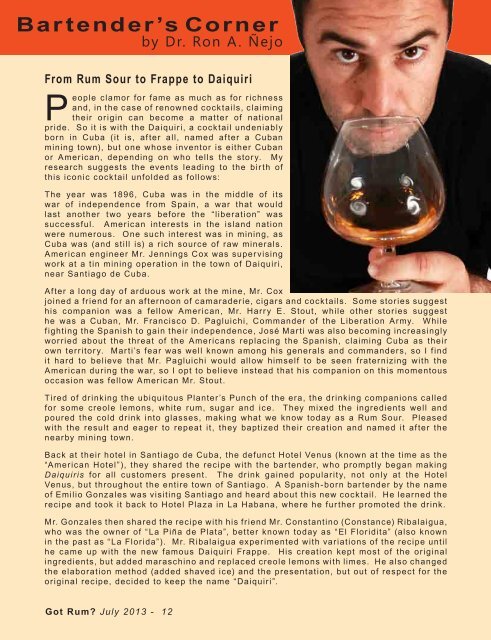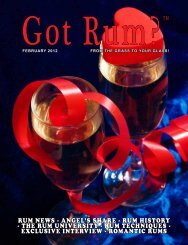Create successful ePaper yourself
Turn your PDF publications into a flip-book with our unique Google optimized e-Paper software.
Bartender’s Corner<br />
by Dr. Ron A. Ñejo<br />
From <strong>Rum</strong> Sour to Frappe to Daiquiri<br />
People clamor for fame as much as for richness<br />
and, in the case of renowned cocktails, claiming<br />
their origin can become a matter of national<br />
pride. So it is with the Daiquiri, a cocktail undeniably<br />
born in Cuba (it is, after all, named after a Cuban<br />
mining town), but one whose inventor is either Cuban<br />
or American, depending on who tells the story. My<br />
research suggests the events leading to the birth of<br />
this iconic cocktail unfolded as follows:<br />
The year was 1896, Cuba was in the middle of its<br />
war of independence from Spain, a war that would<br />
last another two years before the “liberation” was<br />
successful. American interests in the island nation<br />
were numerous. One such interest was in mining, as<br />
Cuba was (and still is) a rich source of raw minerals.<br />
American engineer Mr. Jennings Cox was supervising<br />
work at a tin mining operation in the town of Daiquiri,<br />
near Santiago de Cuba.<br />
After a long day of arduous work at the mine, Mr. Cox<br />
joined a friend for an afternoon of camaraderie, cigars and cocktails. Some stories suggest<br />
his companion was a fellow American, Mr. Harry E. Stout, while other stories suggest<br />
he was a Cuban, Mr. Francisco D. Pagluichi, Commander of the Liberation Army. While<br />
fighting the Spanish to gain their independence, José Marti was also becoming increasingly<br />
worried about the threat of the Americans replacing the Spanish, claiming Cuba as their<br />
own territory. Marti’s fear was well known among his generals and commanders, so I find<br />
it hard to believe that Mr. Pagluichi would allow himself to be seen fraternizing with the<br />
American during the war, so I opt to believe instead that his companion on this momentous<br />
occasion was fellow American Mr. Stout.<br />
Tired of drinking the ubiquitous Planter’s Punch of the era, the drinking companions called<br />
for some creole lemons, white rum, sugar and ice. They mixed the ingredients well and<br />
poured the cold drink into glasses, making what we know today as a <strong>Rum</strong> Sour. Pleased<br />
with the result and eager to repeat it, they baptized their creation and named it after the<br />
nearby mining town.<br />
Back at their hotel in Santiago de Cuba, the defunct Hotel Venus (known at the time as the<br />
“American Hotel”), they shared the recipe with the bartender, who promptly began making<br />
Daiquiris for all customers present. The drink gained popularity, not only at the Hotel<br />
Venus, but throughout the entire town of Santiago. A Spanish-born bartender by the name<br />
of Emilio Gonzales was visiting Santiago and heard about this new cocktail. He learned the<br />
recipe and took it back to Hotel Plaza in La Habana, where he further promoted the drink.<br />
Mr. Gonzales then shared the recipe with his friend Mr. Constantino (Constance) Ribalaigua,<br />
who was the owner of “La Piña de Plata”, better known today as “El Floridita” (also known<br />
in the past as “La Florida”). Mr. Ribalaigua experimented with variations of the recipe until<br />
he came up with the new famous Daiquiri Frappe. His creation kept most of the original<br />
ingredients, but added maraschino and replaced creole lemons with limes. He also changed<br />
the elaboration method (added shaved ice) and the presentation, but out of respect for the<br />
original recipe, decided to keep the name “Daiquiri”.<br />
<strong>Got</strong> <strong>Rum</strong>? July 2013 - 12




